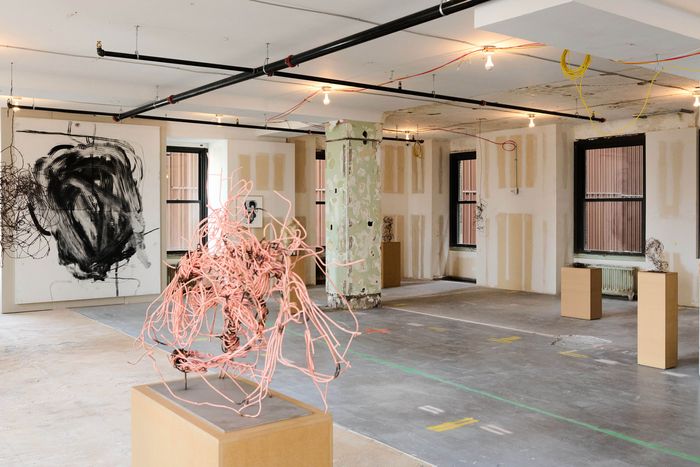
Donald Judd landed in Marfa, Texas, because he was looking for a place that made sense for his work — minimalist sculptures, as smooth and sharp as the Texan skyline. Generations later, the painter Christopher Wool ended up there, as the foundation dedicated to Judd’s legacy invited him for a residency. Wool admired what Judd had found: a landscape that rhymed with his aesthetic. Why should Wool’s next show have to take place in a white box? Could he find his own Marfa?
This March, his first major exhibition since a 2014 retrospective at the Guggenheim will open in the Financial District on the 19th floor of 101 Greenwich, where 18,000 square feet overlook the chasms of the World Trade Center and the spire of Trinity Church. The floor was gutted before the pandemic and left raw, wires exposed, concrete shorn to reveal stripes of original mosaic tile — a distressed vibe that matches the work of a punk painter who came up under the abstract expressionists.
The show’s curator Anne Pontégnie and two artists Wool hired to help her — Rose Marcus and Marie Angeletti — had no idea when they started scouting that they would land in an office. “A lot of what we were looking for was ineffable,” said Marcus. “It’s the actual feeling in the space. Does it feel dead? Does it feel alive? There are things that you can’t put your finger on.” Last January, they met in midtown at a hotel and started touring with brokers — looking at ten or 12 buildings a day. A penthouse off Union Square seemed too slick; an old Duane Reade near Grand Central was too dark; and an artist’s loft off Tenth Avenue was too stylish. At a certain point, they ruled out ground-floor commercial spaces — “too retail,” said Pontégnie. (None of Wool’s work is for sale.) Then they ruled out residential — too private, too exclusive. Finally, they ruled out the brokers, who kept trying to show them pristine, trendy interiors, which is when they realized they were looking for something more raw.
They started crossing Manhattan, looking up at high windows for empty floors, calling any broker’s number pasted in a dark window. They were stunned by just how much was available. “You can read in the newspaper about how much empty space there is,” Marcus said. “But once you taste the level of emptiness — building after building, seeing 12 huge 20,000-square-feet spaces in a matter of four hours — it’s really shocking.”
They found the former office at 101 Greenwich in late January and liked the contrast between the exposed, gutted floor and a formal, once-genteel tower. The 1907 building was designed to house the U.S. Express Company, a shipping company, and its ornate exteriors and views landed major tenants, including Merrill Lynch, Skanska, and architect Daniel Libeskind, who had an office on the 19th floor when he worked as the master planner for the World Trade Center memorial site. In 2013, Kushner Companies bought the building with plans to convert its narrow, windowed floorplates to residential, but the market for office was still hot and they sold it three years later for $65 million more. A group of buyers renovated and rebranded, and, when the pandemic hit, the developer BentallGreenOak was left with a depreciating asset, as workers stayed away; almost one-third of the building is currently advertised as available for rent.
Senior Vice-President Sam Buckley was thrilled by the idea of Wool’s survey — but there were physical challenges, “like, how to activate a totally vacant floor that didn’t have HVAC or a sprinkler loop yet,” and legal challenges, like how to insure against the potential damage caused by allowing the public to traipse through a major asset and hang around art that sells for millions at auction. At the same time, the landlord hoped the show could pull tenants in, making the building feel alive. BGO cooperated, and so did Wool, who had his lawyer form a corporation — mimicking a typical tenant — and loan it the work to get it insured. Neither the landlord nor Wool would say what the financials were, but neither described getting a deal. “He was able to contribute because he’s an artist of means,” Buckley said.
Once they signed for the office, with a one-year lease, the team had to solve their next problem: getting art into an office, where the freight elevator was only slightly taller than the passenger elevators. A 16-foot-wide mosaic had to be moved in pieces, paintings had to be painstakingly pulled off their stretchers and rebuilt upstairs, and some sculptures were left behind.
But it all felt worth it to Wool’s team. His work always shows how it was made — a philosophy that matches a corporate office, stripped and exposed. And then there was the actual look of the place — so similar to Wool’s work that Pontégnie had to avoid hokey matches, like a wire sculpture beneath an exposed wire, a spray-painted painting across from a spray-painted column. On the other hand, “Sometimes you put a pink drawing on a pink wall,” Pontégnie said, “and it really sings.”
“See Stop Run” opens March 14 and runs Thursday through Sunday until July 31.






